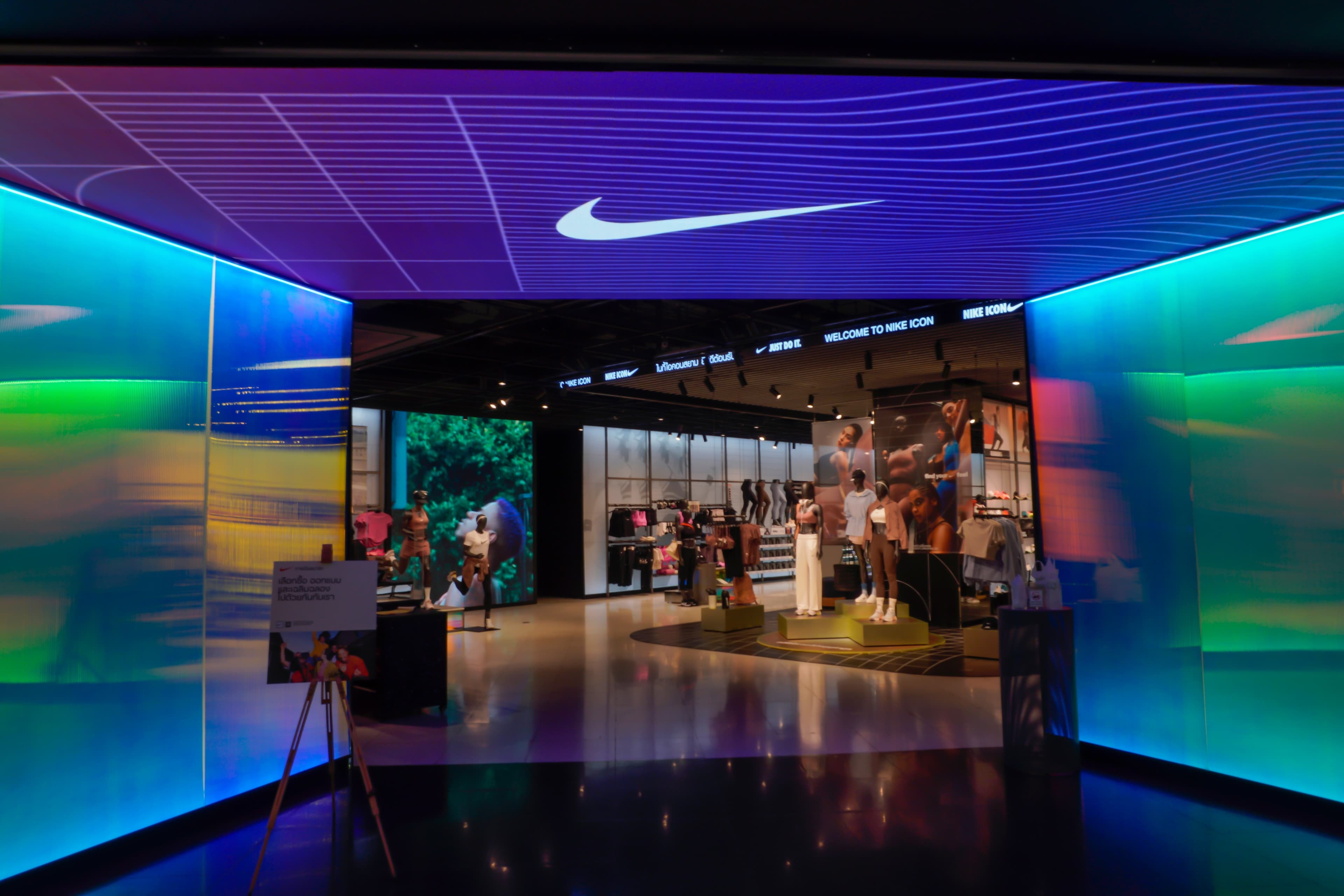Crafting Immersive Store Experiences With Digital Signage

On this page
The future of retail is set to be "hyper-experiential," particularly appealing to younger shoppers. This shift towards experience is driven by several key factors. Firstly, advancements in technology are facilitating innovative and effective experiential retail. Secondly, despite the post-pandemic world, people continue to seek opportunities to spend time outside and engage with others. According to insights from Canvas8 on what they call "experience hunters," 58% of consumers believe immersive experiences influence their purchasing decisions. This means that six out of ten people place a high value on how retail makes them feel.
This places a heavy burden – and incredible opportunity – on physical stores. Stores have evolved beyond the transactional. The physical expression of the store is more compelling and vital than ever as demonstrated by shopper demand for a full sensorial, unforgettable, original, and connected experience from their favorite retailers and brands. I’m seeing new demand for immersive experiences that deliver the wow factor and inform/inspire consumers to expect something unique and memorable – from Banking to Big Box stores.
Digital Signage helps create a place where people want to dwell, not just transact. So, it is often utilized to help with the more practical requirements of a physical environment:
Activate visual merchandising and drive shopability at the shelf.
Provide a contextual and comparative content experience that helps shoppers make decisions that drive sales, reducing cart abandonment.
Help sales associates deliver customer service in ways that are transparent about inventory, new clientelling platforms, and services like click-to-ship or styling advice.
Deliver an element of recognition and personalization that shoppers crave – especially those whose loyalty stems from mobile app usage.
READ MORE: Why Retail Media Networks Are The Future For Stores
The Pandemic Drove Innovation In Stores
In hindsight, the pandemic has been beneficial for technology in retail, accelerating digital adoption and catering to new consumer behaviors. This has resulted in the long-lasting implementation of various convenient features such as frictionless interactivity, mobile-in-store, buy online/pick up in-store or curbside, and new employee and sales associate productivity platforms.
For example, Creative Realities worked with Verizon to install voice-activated display during this time. Driven by the demand of touchless experiences, voice-command digital merchandising was deployed at 1,400 stores to launch 5G Entertainment and 100 to launch 5G at Home. Even with Covid restrictions on store occupancy levels, stores reported positive reactions from customers using the experience, and the company exceeded its sales objectives for entertainment products.
Digital signage technology also drove real change for Calvin Klein in Macy’s. Our main objective was to utilize digital signage to enhance the shopping experience in the denim category. The traditional display and organization of denim products often require customers to physically search through shelves for their preferred style and size, leading to rejected merchandise scattered across the sales floor when they cannot find what they need. Our strategy involved deploying digital signage displays and interactive applications to educate shoppers about fit and sizing, thereby minimizing the need to rummage through inventory to find their perfect fit. As a result, there were improvements in physical merchandising scores, better-maintained floors, and increased satisfaction for both sales associates and shoppers.
Rethinking & Monetizing Digital Signage
Retailers are interested in taking their web- and mobile-based Retail Media Networks (RMNs) and applying that same methodology to the store through digital signage. This allows the retailer to generate advertising dollars to then offset the cost of the network, and to drive incremental revenue and profit from creating in-store media networks. Retailers across categories are executing these strategies to grab and divert budgets allocated to mass media, over to in-store media instead.

This widespread interest in digitalization stems from two primary considerations, namely:
digital’s ability to grab attention and drive behavior…
…and the software behind it that can automate and supercharge its ability to monetize the asset in ways that help defray upfront investment.
Digital signage is a fantastic way to enhance traditional visual merchandising and fixturing. It can educate and inspire customers, whether it's showing how to put together outfits in the fashion industry, suggesting combo meals and recipes in grocery stores, or creating a personalized experience for specialty products like recreational vehicles. Digital signage isn't just limited to large video walls or LED displays; it can also be effectively integrated into shelves to help shoppers make informed decisions and speed up the purchasing process.
DOWNLOAD THE eBOOK: The State Of Data Monetization In Retail Today
Creating Memorable In-Store Experiences
Digitally integrated store environments are highly immersive and serve as a canvas or stage for storytelling, brand building, social media moments, and powerful visual merchandising. This helps to effectively engage customers and bridge the gap between the physical and virtual worlds. With numerous points of customer care, convenience, service, and inspiration, digital technology has become a practical, powerful, and profitable tool to enhance the in-store experience. Retailers who excel in this use digital technology to not only create appealing designs but also to provide exceptional guest service. The era of static "ATMs" or interactive screens in the corner is behind us, as we’ve entered a new age of digital technologies that can sense and respond to customers, recognize them, and adjust the content based on various factors like weather or crowd conditions.
Technology advancements are made possible by more sophisticated software and integrated tech stacks that can cooperate with each other. They can be programmed and engineered to follow specific business rules. AI also enhances user experience through machine learning algorithms that improve recommendation engines and enable voice or facial recognition. When used purposefully, these technologies combine complex systems to deliver a simple yet impactful visual and service experience that defines Retail 2.0.
In-Store Digital Signage Best Practices
There are many ways to revamp in-store signage strategies, but these are my top recommendations:
Do everything you can to help the shopper make decisions while they are navigating a complex store environment.
Avoid duplicating experiences in-store that would be more native for someone browsing or fact-finding at home or on-site.
Refresh the content every two weeks. This is a crucial aspect of the visual merchandising experience, helping to create a sense of newness that is essential for discovery, engagement, and purchase.
Make sure to focus on the metrics that matter to your specific category, department, or business unit. You can measure customer footfall, analyze heat maps to understand traffic patterns, and assess the relationship between digital displays and actual transactions. Utilize video/computer vision and other anonymous analytics tools effectively by setting them up to measure a specific issue over a set period, and ensure there's a control in place for comparison. Depending on the category and the behavior you're trying to understand, anonymous analytics can effectively provide data-driven insights on the customer journey.
READ MORE: Recognizing The Value Of Shopper Journey Analysis In Stores
Insider's Guide: Store Trend Forecast
As for the future of the industry, I imagine smaller store formats, like micro-showrooms, with plenty of "DIY" tools to help customers touch and feel the products they might want or need. Screens could then display the available colors, models, styles, and varieties in stock, offering an improved endless aisle experience. These new store concepts could appear temporarily in mixed-use property spaces, or they could be digital-first brands aiming to make an impact and drive engagement in urban areas.
I also envision mixed-use spaces that combine art, culture, shopping, community, and commerce. This space would offer consumers a unique recreational experience, allowing them to find inspiration, learn, socialize, and engage in commercial activities all in one place. Similar to museums that have a café, a store, and a tranquil lobby, I believe that the concept of combining work, life, and play environments with embedded retail will create a new way to shop, offering immersive and thematic experiences. Shopping malls are beginning to adapt to this model by adjusting rents to accommodate shorter-term leases, making it easier for niche, novel, and emerging brands to establish a presence and build a following with fewer financial barriers. Additionally, I anticipate retail will become more aligned with hospitality, and I’m already witnessing how food and beverage offerings complement shopping and cultural experiences.
In the years ahead, the most compelling retail experiences will be driven by the three c’s: community (creating stores that foster gathering and loyalty), culture (expanding to include other non-commercial and commercial forms of expression), and collaboration (between stores and technology partners, and between brands with intersecting audiences). It’s an exciting time for retail.
About the author:

Beth Warren , SVP of Marketing | Retail SME, Creative Realities Inc.
As Senior Vice President of Marketing at Creative Realities Inc., Beth is well-versed across all areas of the marketing mix, with a concentration on helping brands change consumer behavior through context, content, and environment, as well as how technology innovation can shape brands for the future.




